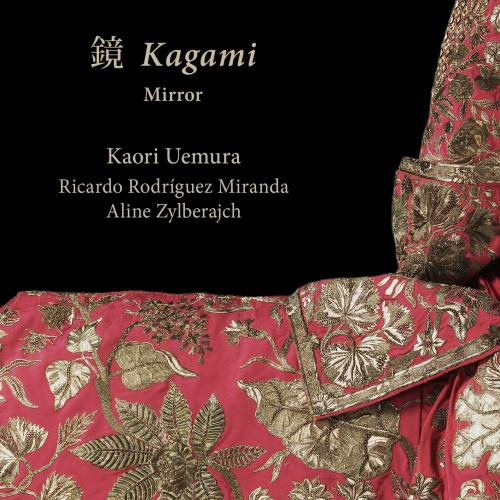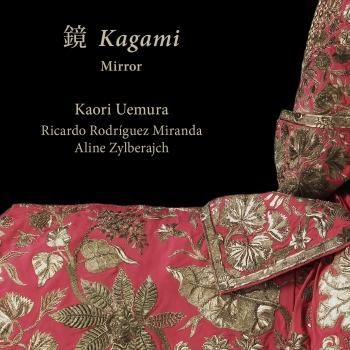
Kagami - Mirror Kaori Uemura, Ricardo Rodriguez Miranda, Aline Zylberajch
Album info
Album-Release:
2023
HRA-Release:
01.09.2023
Label: Ramée
Genre: Classical
Subgenre: Chamber Music
Artist: Kaori Uemura, Ricardo Rodriguez Miranda, Aline Zylberajch
Composer: Tobias Hume (1569-1645), Marin Marais (1656-1728), Johann Sebastian Bach (1685-1750), Charles Dollé (1710-1755), Henry Purcell (1659-1695), François Couperin (1668-1733)
Album including Album cover Booklet (PDF)
- Tobias Hume (1569 - 1645): The First Part of Ayres, French, Pollish and Others:
- 1 Hume: The First Part of Ayres, French, Pollish and Others: No. 15, Good againe 05:50
- Marin Marais (1656 - 1728): 5e livre de pièces de viole, Suite in F Major:
- 2 Marais: 5e livre de pièces de viole, Suite in F Major: Prélude en harpègement 01:46
- 3 Marais: 4e livre de pièces de viole, Suite d’un goût étranger: La fougade 02:45
- Johann Sebastian Bach (1685 - 1750): Sonata a Viola da Gamba e Cembalo Obligato in D Major, BWV 1028:
- 4 Bach: Sonata a Viola da Gamba e Cembalo Obligato in D Major, BWV 1028: I. Adagio 01:41
- 5 Bach: Sonata a Viola da Gamba e Cembalo Obligato in D Major, BWV 1028: II. Allegro 04:10
- Charles Dollé (1710 - 1755): Première Suitte:
- 6 Dollé: Première Suitte: I. Prélude 01:33
- 7 Dollé: Première Suitte: II. Allemande "La Mantrÿ" 03:07
- 8 Dollé: Première Suitte: III. Le Tendre Engagement 04:08
- 9 Dollé: Première Suitte: IV. Rondeau "Le Gruer" 02:17
- 10 Dollé: Première Suitte: V. Sarabande 02:43
- 11 Dollé: Première Suitte: VI. Fugue 04:25
- 12 Dollé: Première Suitte: VII. Musette "La Favoritte" 03:29
- 13 Dollé: Première Suitte: VIII. La Badine 02:17
- Johann Sebastian Bach: Sonata a Viola da Gamba e Cembalo Obligato in D Major, BWV 1028:
- 14 Bach: Sonata a Viola da Gamba e Cembalo Obligato in D Major, BWV 1028: III. Andante 04:16
- Henry Purcell (1659 - 1695): Dido and Aeneas, Z. 626, Act III:
- 15 Purcell: Dido and Aeneas, Z. 626, Act III: When I am laid in earth (Transcr. for Viola da Gamba by Ryosuke Sakamoto) 03:57
- Francois Couperin (1668 - 1733): Pièces de Violes, Deuxième suite:
- 16 Couperin: Pièces de Violes, Deuxième suite: III. Pompe funèbre. Très gravement 04:18
- Johann Sebastian Bach: Italian Concerto in F Major, BWV 971:
- 17 Bach: Italian Concerto in F Major, BWV 971: II. Andante 04:27
- Marin Marais: 2e livre de pièces de viole, Suite in A Major:
- 18 Marais: 2e livre de pièces de viole, Suite in A Major: Fantaisie 05:47
Info for Kagami - Mirror
The yamato word for mirror, 鏡kagami, can be read as “kami (divinity) surrounding ga (self)”: if you look in a mirror, what you see is your own self surrounded by divinity. Kaori Uemura has called her tale Kagami , because she believes that music reflects the inner depths of the self in the same way as a mirror. Mirrors were used in art as a reflection of what is, and as an allegory of truth and wisdom, a means of knowing yourself as you are. This recording is also a tribute to the Baroque composers who saw music not only as a mirror of divine creation, but equally as a means of expressing human emotions through musical figures which could produce specific affects.
Kaori Uemura, viola da gamba
Ricardo Rodriguez Miranda, viola da gamba
Aline Zylberajch, harpsichord
Kaori Uemura
was born in Japan and began playing the violin at the age of three. She was advised by a relative to take up the viola da gamba when she was twelve and subsequently studied with Toshinari Ohashi, a pioneer of the instrument in Japan.
She graduated from Ueno Gakuen University in Tokyo and was selected to play for the Emperor of Japan at the Imperial Palace. She then moved to Brussels, where she not only studied but also performed in concert with Wieland Kuijken.
She settled in Belgium after her graduation from the Royal Conservatory of Brussels and rapidly became one of the most sought-after gambists in Europe for performances and recordings. She founded the Tokyo Baroque Trio with Christophe Rousset and Ryo Terakado and has also accompanied Agnès Mellon and Sandrine Piau. She performs with the Ricercar Consort, Armonia Sonora, Poème Harmonique and Les Talens Lyriques, ensembles with whom she has created beautiful and trusting relationships. She has also taken part in various opera productions with Les Arts Florissants and the Musiciens du Louvre as part of the continuo group.
She has since embarked on a solo career after intense work on refocusing herself with Michèle Massina; her album Yuu was released by Ramée in 2020.
She shares her experience and ideas with young musicians by mentoring newly formed groups and through her teaching at the Royal Conservatory in Brussels.
Ricardo Rodriguez Miranda
Born in 1973 in Caracas, Venezuela. At the beginning, piano and music theory were taught by his grandmother. Shortly after he continued in a music school with cello and piano as main subjects. During this period, he became deeply interested in early music and historical instruments. At the end his years in Venezuela, he became a member of La Camerata de Caracas of Isabel Palacios, lead the ensembles Terpsichore and Acantus and in 1991, plays in the first digital recording made in Venezuela of F. Couperin’s Les Concerts Royaux with the group Musica Rhetorica.
In the year 1992, Ricardo Rodríguez Miranda was awarded a scholarship from the Venezuelan Council of Culture (CONAC) to study with Wieland Kuijken at the Royal Conservatory in The Hague, The Netherlands. He played in projects directed by Ton Koopman, William Christie and in a Dutch tournée with the NDT. He went also to summer courses to have Master classes with Jordi Savall. In 1998, Ricardo got the diploma Teacher and Performer from the conservatory. Nevertheless, he continued to study Musicology until 2002 at the University of Utrecht.
From the first decade of the 21st century, Ricardo Rodríguez Miranda has been performing as a soloist in Bach’s St. Matthew’s Passion with several Dutch orchestras and choirs like Het Residentie Orkest, Toonkunstkoor Amsterdam and Toonkunst Rotterdam. He has had the privilege to work for masters as Gustav Leonhardt, Peter Schreier, Colin Davies, Richard Egarr, Jan Willem De Vriend and Jaap van Zweden.
Ricardo Rodríguez Miranda’s viola da gamba playing is to be listened in recordings like Salades et Bombes Catalanes (Camerata de Caracas), Sonates of Leclair (with L.O. Santos and A. Santoro), Membra Jesu Nostri (Nederlandse Bachvereniging), Schütz’s Musicalische Exequien (Vox Luminis) and Forqueray (with M. Dévérité, K. Uemura, R. Terakado and R. Kohnen).
Given to his restlessness to catch the ephemeral, the baroque dance obtained a special place in the life Ricardo Rodríguez Miranda. Specifically the notation Beauchamps – Feuillet that offers him not only another approach in art but also a good fitness exercise. Since 2011 he is the baroque dance teacher of the early music department at the Royal Conservatory in The Hague.
He is a regular member of the ensembles Vox Luminis, Netherlands Bach Society, Margaretha Consort and L’armonia sonora.
Aline Zylberajch
After graduating from the Conservatoire National Supérieur de Musique de Paris, and taking lessons with Ton Koopman in Amsterdam, Aline Zylberajch went on to a Master of Music at the New England Conservatory of Music in Boston She started her career as a harpsichordist. However, her interest in the music of the late 18th century has led her naturally to an intensive involvement in the performance practice of the early piano and the amazing variety of instruments built at that time. Hence her solo repertoire as a soloist includes music by Byrd, Frescobaldi, Froberger, the French harpsichord composers, J.S. Bach and his sons, Haydn, Mozart as well as their many less known contemporaries. One of her other addictions is vocal music : she has taken part in many opera productions, and she greatly enjoys accompanying soloists, for baroque music as well as Lieder evenings. She has also appeared with many instrumental ensembles, such as Les Musiciens du Louvre, and smaller chamber ensembles including les Nièces de Rameau, Alice Piérot and her trio AnPaPié. She has been regularly invited as a soloist by the Polish baroque orchestra Arte di Suonatori and collaborates regularly with "Le Parlement de Musique".
Aline Zylberajch has participated in over sixty recordings and has recorded for the radio in many European countries. Among her recordings, those featuring music by Froberger "from a rediscovered manuscript", and François Couperin, "Portrait de l’Amour" (ASSAI), Rameau, pièces de clavecin en concerts, " (Accor ), CPE Bach "Sonates Prussiennes" (Ligia) , Scarlatti’s sonatas (recorded on Denzil Wraight’s reconstruction of a Cristofori fortepiano, AMBRONAY ), Psalterion ( music for fortepiano and psalterion, with Margit Übellacker, AMBRONAY) Haydn ( Ariana a Naxos , Lieder and Canzonettas with Stéphanie d’Oustrac, AMBRONAY) Cantatas with BC by Scarlatti with Max Emmanuel Cencic ( Cappriccio) have been highly praised by the critics (Diapason d’or, 10 de Répertoire, Choc du Monde de la Musique, Recommandé par Classica, Gramophone, Early Music Review…)
Booklet for Kagami - Mirror










